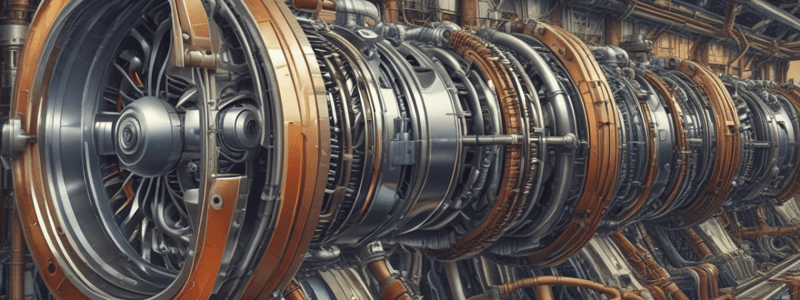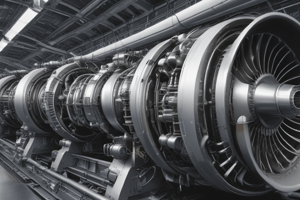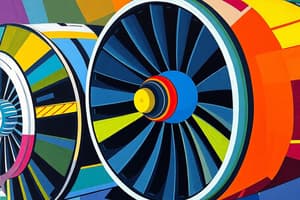Podcast
Questions and Answers
What type of bearings are not used as main bearings in turbine engines?
What type of bearings are not used as main bearings in turbine engines?
- Plain bearings (correct)
- Roller bearings
- Deep-groove bearings
- Ball bearings
What determines the number of main bearings required in a gas turbine engine?
What determines the number of main bearings required in a gas turbine engine?
- Type of bearing used
- Length and weight of the rotor shaft (correct)
- Type of compressor
- Speed of operation
What type of loading do ball bearings support in a gas turbine engine?
What type of loading do ball bearings support in a gas turbine engine?
- Neither axial nor radial loads
- Only axial loads
- Both axial and radial loads (correct)
- Only radial loads
What is the advantage of using roller bearings in a gas turbine engine?
What is the advantage of using roller bearings in a gas turbine engine?
What is the minimum number of bearings required to support one shaft in a gas turbine engine?
What is the minimum number of bearings required to support one shaft in a gas turbine engine?
What is the reason for using anti-friction type bearings in a gas turbine engine?
What is the reason for using anti-friction type bearings in a gas turbine engine?
What is the purpose of the fins on a thread type labyrinth seal?
What is the purpose of the fins on a thread type labyrinth seal?
What is the main difference between hydraulic seals and labyrinth or ring seals?
What is the main difference between hydraulic seals and labyrinth or ring seals?
What compensates for any difference in air pressure inside and outside of the bearing chamber in a hydraulic seal?
What compensates for any difference in air pressure inside and outside of the bearing chamber in a hydraulic seal?
What is the main characteristic of the running clearance in a ring seal?
What is the main characteristic of the running clearance in a ring seal?
What is the purpose of the annulus of oil in a hydraulic seal?
What is the purpose of the annulus of oil in a hydraulic seal?
What happens when the shaft comes into contact with the ring in a ring seal?
What happens when the shaft comes into contact with the ring in a ring seal?
What is the primary function of the ball bearing in the engine configuration?
What is the primary function of the ball bearing in the engine configuration?
What is a common disadvantage of both ball and roller bearings?
What is a common disadvantage of both ball and roller bearings?
What is the primary purpose of the bearing seals in the main engine bearings?
What is the primary purpose of the bearing seals in the main engine bearings?
What type of seal is commonly used for main bearing chamber sealing?
What type of seal is commonly used for main bearing chamber sealing?
Why is air cooling of the engine bearing chambers not normally necessary?
Why is air cooling of the engine bearing chambers not normally necessary?
Where are the bearing chambers typically located in the engine?
Where are the bearing chambers typically located in the engine?
What is the purpose of a double-skinned bearing housing with cooling air fed into the intermediate space?
What is the purpose of a double-skinned bearing housing with cooling air fed into the intermediate space?
What is the purpose of the finned rotating member in a labyrinth seal?
What is the purpose of the finned rotating member in a labyrinth seal?
What is the effect of the pressure drop across each seal fin in a labyrinth seal?
What is the effect of the pressure drop across each seal fin in a labyrinth seal?
What is the purpose of the oil in a labyrinth air/oil seal?
What is the purpose of the oil in a labyrinth air/oil seal?
What is the difference between a labyrinth air seal and a labyrinth air/oil seal?
What is the difference between a labyrinth air seal and a labyrinth air/oil seal?
Why do labyrinth air/oil seals have greater fin clearance than air seals?
Why do labyrinth air/oil seals have greater fin clearance than air seals?
What is the reason for not using ring seals in hot areas?
What is the reason for not using ring seals in hot areas?
What is the purpose of the springs in a carbon seal?
What is the purpose of the springs in a carbon seal?
What is the characteristic of carbon seals that requires special care during handling?
What is the characteristic of carbon seals that requires special care during handling?
What is the material used to manufacture the bristles of a brush seal?
What is the material used to manufacture the bristles of a brush seal?
Where are brush seals typically used in a gas turbine engine?
Where are brush seals typically used in a gas turbine engine?
What is the angle of the brush seal bristles relative to the tangent of the adjacent shaft?
What is the angle of the brush seal bristles relative to the tangent of the adjacent shaft?
Flashcards are hidden until you start studying
Study Notes
Engine Bearings
- Engine main bearings are located along the length of the rotor shaft and are critical for support.
- The number of bearings required is determined by the length and weight of the rotor shaft.
- Ball bearings support both axial (thrust) and radial (centrifugal) loads, while roller bearings only support radial loads.
- A minimum of one deep-groove ball bearing and one straight roller bearing are required to support one shaft.
Main Bearing Configuration
- The main bearings are typically a combination of ball and roller bearings.
- This configuration allows for engine flexibility during operation and temperature changes.
Disadvantages of Ball and Roller Bearings
- Both are vulnerable to damage from foreign matter.
- Both can fail without warning, making proper lubrication and sealing essential.
Bearing Housing and Sealing
- The main engine bearings are housed in a bearing support or housing.
- The support forms a chamber that separates the bearing from the engine core cavity.
- Bearing seals keep lubricating oil and oil mist from entering the engine core.
Labyrinth Seals
- Labyrinth seals are commonly used for main bearing chamber sealing.
- They have no contacting parts and prevent oil leakage by controlling opposing air leakage into the chamber.
- Air cooling of the engine bearing chambers is not normally necessary, but can be achieved through a double-skinned bearing housing with cooling air fed into the intermediate space.
Labyrinth Seal Variations
- Labyrinth air seal: used to prevent oil leakage and consists of a finned rotating member with a static bore lined with a soft abradable material or a high-temperature honeycomb structure.
- Labyrinth air/oil seal: uses a rotating annulus of oil to prevent heat build-up due to seal rub caused by shaft flexing.
- Thread type labyrinth seal: forms a helical path similar to a screw thread, allowing for a metered amount of compressor air to flow into the bearing chamber.
Other Types of Seals
- Hydraulic seals: used to seal a bearing chamber, but do not allow a controlled flow of air to traverse across the seal.
- Ring seals: used for bearing chamber sealing, except in hot areas where oil degradation due to heat would lead to ring seizure.
- Carbon seals: consist of a static ring of carbon that constantly rubs against a collar on a rotating shaft, relying on a high degree of contact to prevent oil or air leakage.
- Brush seals: circumferential seals made of high-temperature nickel-cobalt alloy bristles, used in large or small gas turbine secondary and tertiary flow gas paths.
Studying That Suits You
Use AI to generate personalized quizzes and flashcards to suit your learning preferences.




